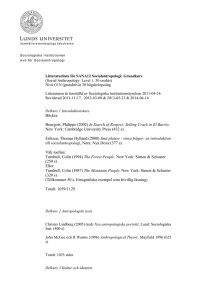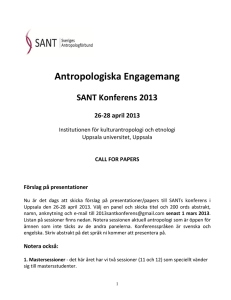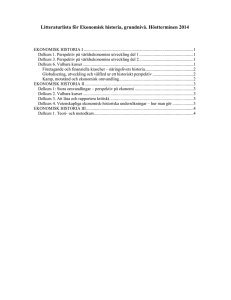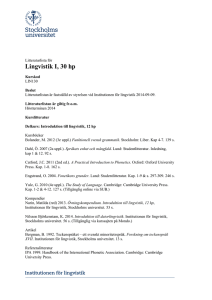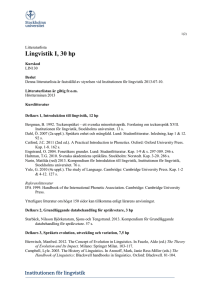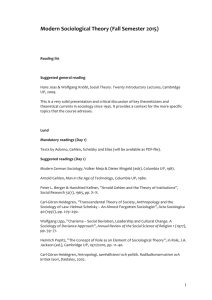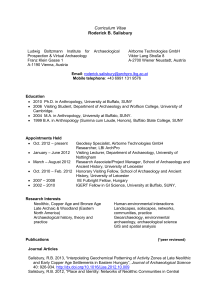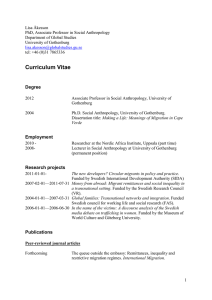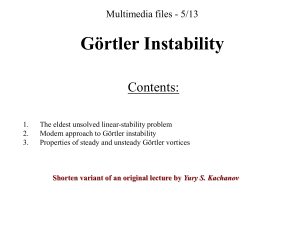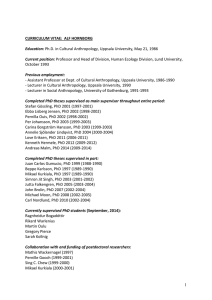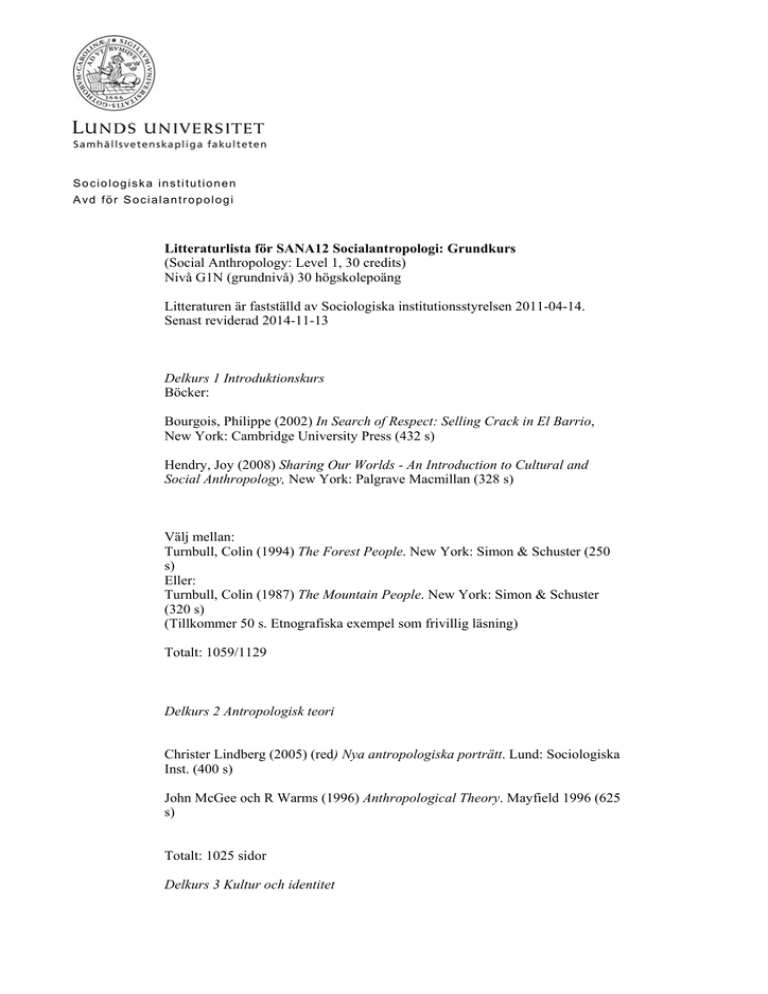
Sociologiska institutionen
Avd för Socialantropologi
Litteraturlista för SANA12 Socialantropologi: Grundkurs
(Social Anthropology: Level 1, 30 credits)
Nivå G1N (grundnivå) 30 högskolepoäng
Litteraturen är fastställd av Sociologiska institutionsstyrelsen 2011-04-14.
Senast reviderad 2014-11-13
Delkurs 1 Introduktionskurs
Böcker:
Bourgois, Philippe (2002) In Search of Respect: Selling Crack in El Barrio,
New York: Cambridge University Press (432 s)
Hendry, Joy (2008) Sharing Our Worlds - An Introduction to Cultural and
Social Anthropology, New York: Palgrave Macmillan (328 s)
Välj mellan:
Turnbull, Colin (1994) The Forest People. New York: Simon & Schuster (250
s)
Eller:
Turnbull, Colin (1987) The Mountain People. New York: Simon & Schuster
(320 s)
(Tillkommer 50 s. Etnografiska exempel som frivillig läsning)
Totalt: 1059/1129
Delkurs 2 Antropologisk teori
Christer Lindberg (2005) (red) Nya antropologiska porträtt. Lund: Sociologiska
Inst. (400 s)
John McGee och R Warms (1996) Anthropological Theory. Mayfield 1996 (625
s)
Totalt: 1025 sidor
Delkurs 3 Kultur och identitet
2
Höjdestrand, Tova (2009) Needed by Nobody: Homelessness and Humanness in
Post-Socialist Russia. Ithaka and London: Cornell University Press (231 s)
Mead, Margaret (1935/2001) Sex and Temperament in Three Primitive
Societies. NY: Harper Collins. (310 s)
(Svensk titel: Kvinnligt, manligt, mänskligt. (1968). Stockholm: Bonniers)
Lutz, Catherine (1988) Unnatural Emotions: Everyday Sentiments on a
Micronesian Atoll and the Challenge to Western Theory. Chicago: Chicago
University Press (273 s)
Artiklar:
Brown, Michel (1999) The New Alienists: Healing Shattered Selves at
Century´s End. I: George E. Marcus (red), Paranoia Within Reason: A
Casebook on Conspiracy as Explanation, s. 137-156. Late Editions 6: Cultural
Studies for the End of the Century. Chicago: University of Chicago Press (21s)
(tillgänglig på: http://lanfiles-vm.williams.edu/mbrown/BrownAlienistsUCP99.pdf)
D’Andrade, Roy (1992) Cognitive Anthropology. I: Schwartz, White & Lutz
(red), New Directions in psychological anthropology, s 47-58. Cambridge:
Cambridge University Press. (11s)
Eriksen, Thomas Hylland (1996) The Nation as a Human Being – a Metaphor in
a Mid-Life Crisis? I: Olwig, Karen Fog och Kirsten Hastrup (red), Siting
Culture: The Shifting Anthropological Object, s. 103-121. Hoboken: Routledge.
(19s) (Finns som e-bok på LUB.)
Eriksen, Thomas Hylland (1995) We and Us: Two Modes of Group
Identification. Journal of Peace Research 32(4):427-436
Scheper-Hughes, Nancy (1992) Hungry Bodies, Medicine and the State:
Towards a critical psychological anthropology. I: Schwartz, White & Lutz
(red), New Directions in Psychological Anthropology, s. 221-245. Cambridge:
Cambridge University Press (24s)
Snow, David A. och Leon Anderson (1987) Identity Work Among the
Homeless: The Verbal Construction and Avowal of Personal Identities.
American Journal of Sociology 92(6):1336-1371
Strauss, Claudia och Naomi Quinn (1994) A Cognitive/Cultural Anthropology.
In Borofsky, Robert (red), Assessing Cultural Anthropology, s. 284-295. New
York: McGraw-Hill (22s)
Totalt: 954 s.
Delkurs 4 Aktuella frågor i socialantropologi I
3
Böcker:
Graeber, David (2001) Toward an anthropological theory of value the false
coin of our own dreams. New York: Palgrave (150 s i urval)
Lövgren, Orvar & Frykman, Jonas (1979) Den kultiverade människan.
Stockholm: Liber (230 s)
Masquelier A (red), Dirt, Undress, and Difference. Critical Perspectives on the
Body Surface: 1–251.
Wittrock H (2011), Säg inte mötesplats! Teater och integration i ord och
handling: Lund monographs in social antropology 1101-9948; 21 (200 s i
urval).
Österberg, Jacob (2011) Märken och människor: om marknadssymboler som
kulturella resurser. Lund: Studentlitteratur AB (163s)
Artiklar:
Gondola C Didier (1999), “Dream and Drama: The Search for Elegance among
Congolese
Youth”, i African Studies Review, vol 42, nr 1 (15 s)
Goffman, Erving.
“Symbols of Class Status” I The British Journal of
Sociology, Vol. 2, No. 4 (Dec., 1951), s. (6 s)
Entwistle Joanne (2000) “Fashion and the Fleshy Body: Dress as Embodied
Practice”. I Fashion
Theory: The Journal of Dress, Body & Culture, vol4, nr3 (25 s)
Friedman J (1994), “The Political Economy of Elegance”, i Cultural Identity
and Global Process
(15 s)
Ince K (1998), “Operations of Redress”, i Fashion Theory 2 (2) (17 s)
Rosen, Carol (1979) “Performance As Transformation: Richard Schechner's
Theory of the
Play/Social Process Knot” Nr. 44/45 (8 s)
Sapir E (1931), “Fashion”, i Encyclopedia of the Social Sciences: (5 s).
Simmel G (1957), “Fashion”, i The American Journal of Sociology, vol
62, nr 6: 541–558. Frivillig läsning:
Kroeber, A. L. On the Principle of Order in Civilization as Exemplified byC
hanges of Fashion" I American Anthropologist, New Series, Vol. 21, No. 3 (Jul.
- Sep., 1919), s. 235-250
Zimbardo P G (1999-2009), “Stanford Prison Project” (elekronisk version)
http://www.prisonexp.org/
Totalt antal sidor: 902s

